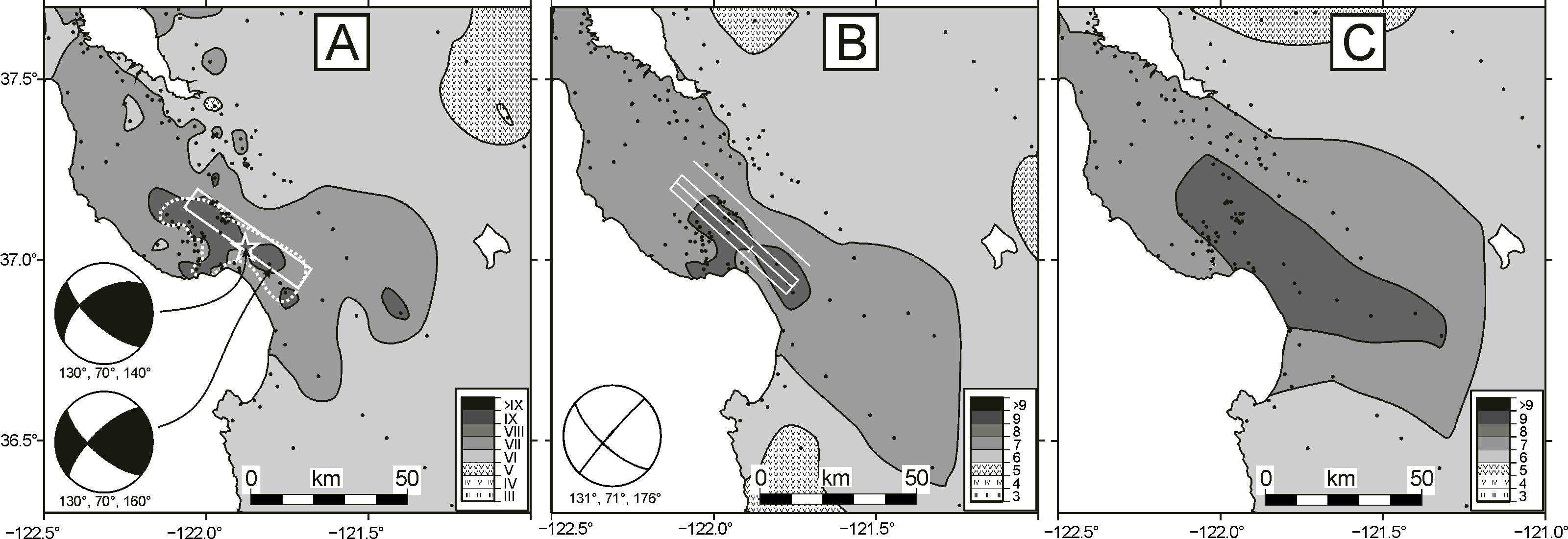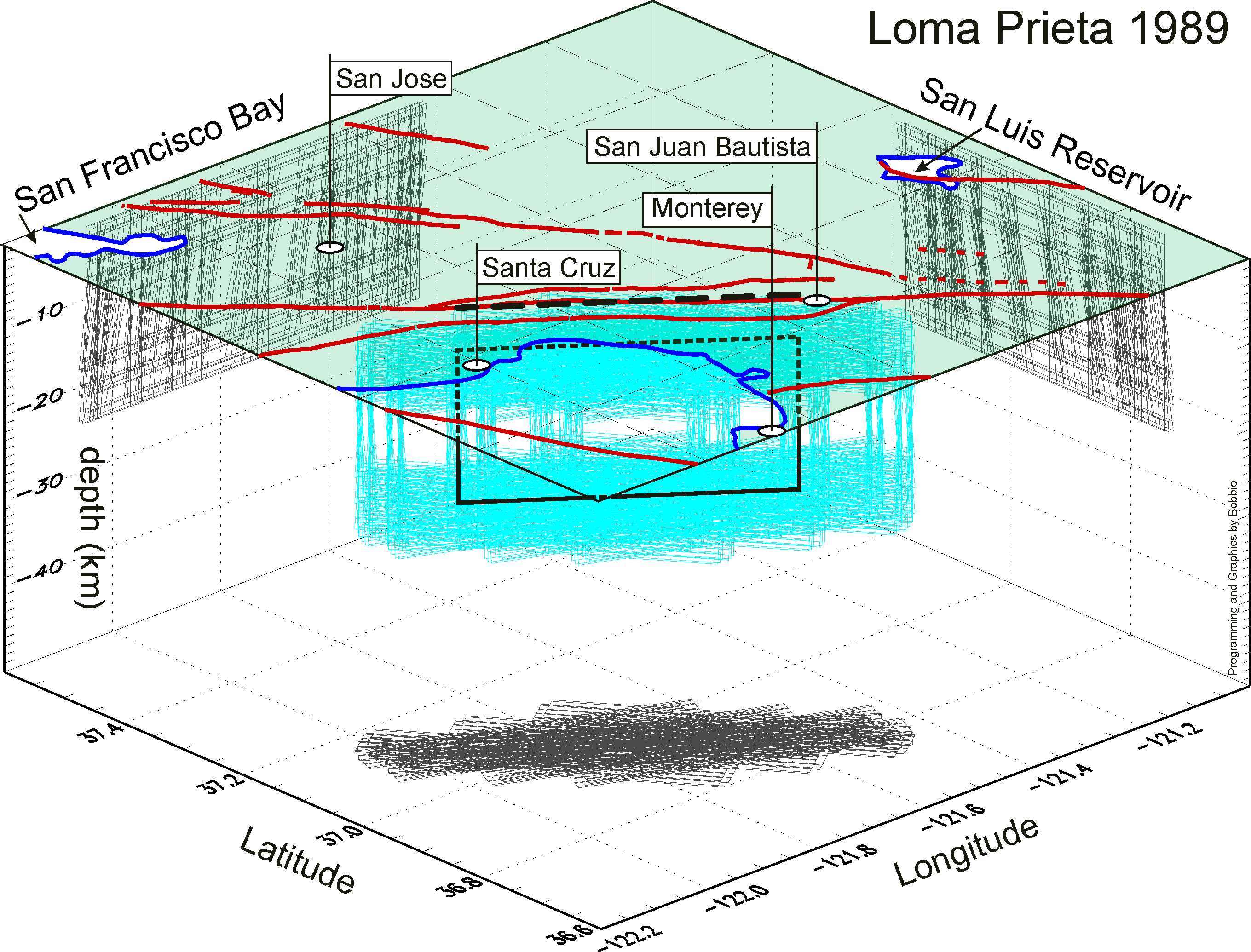Calculation of Earthquake Scenarios for Civil Protection Purposes by the KF formula
«SITAR»
Sismologia Ingegneristica e Tecniche Applicate al Rischio
First matter: the inverse and direct use of our original kinematic model (KF), which calculates the body-wave radiation from a linear source, in terms of macroseismic intensity and of particle displacements.
Second matter: seismic microzoning and 1D elastic and anelastic (also in water saturated soils) calculation of seismic responses of sites for engineering applications.
See below the international references on these OGS techniques.
Here we show an example of the 1st part of the 1st matter, i.e. the calculation of earthquake scenarios by the parametric direct use of the KF formula.
EXCLUSIVE by OGS
Calculation of Earthquake Scenarios for Civil Protection Purposes by the KF formula
Our technique is applicable also to the fast forecast (from tens of minutes to a couple of hours after the earthquake) of the regional pattern of damage of destructive earthquakes (see a recent example of this in Pettenati et al., 2011). The source uncertainties are treated by grid search for giving the standard deviations of the estimates.
Figure1 shows the damage (intensity) scenario we calculated SE of San Francisco (which is in the upper left corner of thefigure) to match the damage observed in the field after the strong earthquake in1989. See the description of the technique and of the case of study in Sirovich andPettenati (2009b).
Extended legend of Figure 1.
Figure 1A: DATA USED FOR INVERSION. The intensities used for our KF inversion were observed in 1989 by the US Geological Survey in the black dots after the Ms 7.1, 1989 Loma Prieta, California earthquake; the isoseismals were drawn with our natural-neighbor contour (Sirovich et al., 2002). Other reference data for validation: the white star and the white rectangle are the epicenter and the projection of the source by Wald et al. (1991);the white dotted curve is the isoseismal of VIII degree according to Stover et al. (1990); the upper fault-plane solution is by both Oppenheimer (1990) and Choy and Boatwright (1990); an almost pure strike-slip mechanism was proposed by various authors for the southern part of the fault, the one shown in the lower beach ball rounds the rake by Beroza (1991) and Steidl et al. (1991).
Figure 1B: OUR KF RESULTS (from AUTOMATED INVERSION). Nucleation, projection of the bilateral source and its virtual intersection with the topographical surface, fault-plane solution, and synthetic isoseismals of the minimum variance solution obtained by the KFtechnique. Note the almost perfect match of the dark grey area (VIII degree).
Figure 1C: OUR EXERCISE OF BACK-PREDICTING THE SCENARIO IN 1988 by using only the pre-1988 seismotectonic knowledge. 59,049 parametric sources were used for this exercise (see details in Sirovich and Pettenati (2009b).
Figure 2, which follows, shows an axonometric view of the same area in Figures 1 A-C, seen from the SW; a selection of the 59,049 sources used is visible in light blue (with their projections on the box walls in dark grey).
Figure 2. We are SW of San Francisco, in the area of the Santa Cruz - Monterey Bay. Solid land is light green and the ocean is white (the bottom of the bay is crossed by the San Gregorio-Hosgri Fault, in red). The traces of the principal faults on land are simplified from Wesnousky (1986). The black heavy-dashed line is the trace of the fault segment, for which the highest cumulative probability of occurrence before 2012 was calculated by Lindh in 1983. The black rectangle schematizes the central fault plane of the 59,049 sources used (the light blue rectangles are a choice from them). See their vertical and horizontal projections on the box walls in dark grey.
The conclusion of this work is that - if KF would have been available in 1988 - a cautious scenario could have been predictable for any potential future earthquake SE of San Francisco (namely for that in 1989)
Let us add here a list ofselected publications of ours dealing with seismic scenarios
Pettenati F., Sirovich L. and D. Sandron (2011). Rapid simulation of seismic intensity for civil protection purposes; two recent cases in Italy. Seism. Res. Lett., 82, 3, 420-430.
Sirovich L., Pettenati F. and Sandron D. (2009). Source- and site-effects in the intensities of the M5.4 July 29, 2008 Earthquake in South Los Angeles. Seismological Research Letters, 80, 6, 936-945.
Bungum H., Pettenati F., Schweitzer J., Sirovich L. and Faleide J.I. (2009). The M 5.4 October 23, 1904, Oslofjord earthquake: Reanalysis based on macroseismic and instrumental data. Bull. Seism. Soc. Am., in press.
Sirovich L. and F. Pettenati (2009). Validation of a Kinematic and Parametric Approach to Calculating Intensity Scenarios. Soil Dynamics and Earthquake Engineering, 29, 1113-1122. doi:10.1016/j.soildyn.2008.12.007.
Sirovich L. and Pettenati F. (2008). Achievements and doubts on the new use of Intensity: inversion for unknown sources, future scenarios, hazard, rapid information. Special Sessionof the 2008 Annual Meeting of the Seismological Society of America, April 16-18, Santa Fe, New Mexico, USA:"Advances in Treating Macroseismic Intensity Data Quantitatively" Abstract Number: 08-139(envited). Seism. Res. Lett., 79, 2, p. 313.
Pettenati F., Sirovich L. and Sandron D. (2008). MMI and ShakeMap® intensities, plus a new back-predicted scenario of the Loma Prieta, 1989 earthquake. Proc. 31st General Assembly of the European Seismological Commission ESC 2008, Hersonissos, Crete, Greece, 7-12 September 2008 ID398_20_06_08_06_18_19.
Pettenati F. and Sirovich L. (2007a). Intensity-Based Source Inversion of Three Destructive California Earthquakes, Bull. Seism. Soc. Am., 97, 5, 1587-1606.
Sirovich L. and Pettenati F. (2007b). A new Kinematic Approach to Calculate Seismic Hazard Scenarios (Intensity and Peak Ground Displacement); an Example in SE Sicily. AGU2007, Acapulco, Proc. ref. n. S51A-01.
And, for our original contour technique used:
Sirovich L., Pettenati F., Cavallini F. and Bobbio M. (2002). Natural-Neighbor Isoseismals. Bull. Seism. Soc. Am., Vol. 92, 5, 1933-1940.


